Archive:Manufacture of leather and related products statistics - NACE Rev. 2
This Statistics Explained article is outdated and has been archived - for recent articles on structural business statistics see here.
- Data from April 2013. Most recent data: Further Eurostat information, Main tables and Database.
This article presents an overview of statistics for leather and related products manufacturing in the European Union (EU), as covered by NACE Rev. 2 Division 15.
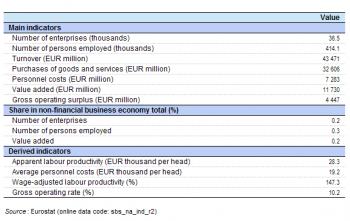
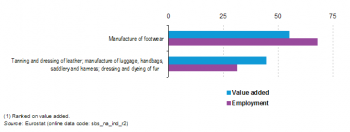
(% share of sectoral total) - Source: Eurostat (sbs_na_ind_r2)



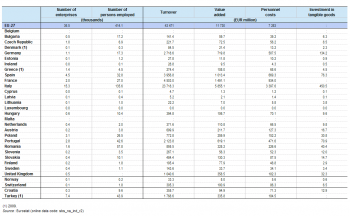
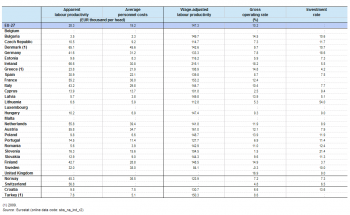


(% share of sectoral total) - Source: Eurostat (sbs_sc_ind_r2)

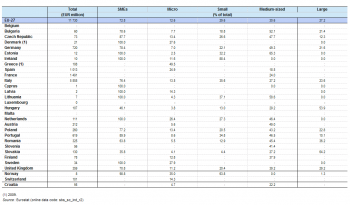
Main statistical findings
Structural profile
There were 36.5 thousand enterprises operating with leather and related products manufacturing (Division 15) as their main activity in the EU-27 in 2010. Together they employed 414.1 thousand persons, equivalent to 0.3 % of the total number of persons employed in the non-financial business economy (Sections B to J and L to N and Division 95) and 1.4 % of the manufacturing (Section C) workforce. They generated EUR 11.7 billion of value added which was 0.2 % of the non-financial business economy total and 0.7 % of the manufacturing total.
The apparent labour productivity of the EU-27’s leather and related products manufacturing sector in 2010 was EUR 28.3 thousand per person employed; this was just over half the manufacturing average (EUR 52.8 thousand per person employed) and was the equal second lowest level of apparent labour productivity among the manufacturing NACE divisions in 2010 (higher only than the manufacture of wearing apparel, Division 14) and the same level as for furniture manufacturing (NACE Division 31). In line with this low apparent labour productivity ratio, the EU-27’s leather and related products manufacturing sector also recorded a low level of average personnel costs, EUR 19.2 thousand per employee in 2010. This was also the second lowest value across the manufacturing NACE divisions, and was also a little more than half the manufacturing average (EUR 35.8 thousand per employee). As for wearing apparel manufacturing, these relatively low values may reflect an above average incidence of part-time work, as both of these indicators are compiled on a per head basis using a simple head count. By contrast, the wage-adjusted labour productivity ratio combines the two previous indicators in percentage terms; and shows the extent to which value added per person employed covers average personnel costs per employee. This latter ratio was 147.3 % for the EU-27’s leather and related products manufacturing sector in 2010, less than 1.0 percentage point below the manufacturing average (148.0 %).
The gross operating rate for the EU-27’s leather and related products manufacturing sector in 2010 shows that the gross operating surplus was 10.2 % of turnover, above the manufacturing average and fractionally above the non-financial business economy average (10.1 %).
Sectoral analysis
The manufacture of footwear (Group 15.2) was the larger of the two subsectors within the EU-27’s leather and related products manufacturing sector. Footwear manufacturing enterprises made up 57.8 % of the enterprise population, and they generated 55.2 % of sectoral value added and employed more than two thirds (68.1 %) of the sectoral workforce. The second subsector covering the tanning and dressing of leather, dressing and dyeing of fur, and the manufacture of other leather products such as luggage, handbags, saddlery and harnesses (Group 15.1; hereafter referred to as leather and fur processing) accounted for the remainder of the activity within the EU-27’s leather and related products manufacturing sector.
Apparent labour productivity per person employed in 2010 varied greatly between the two leather subsectors in the EU-27, ranging from a low of EUR 23 thousand for footwear manufacturing to a high of EUR 40 thousand for the smaller subsector of leather and fur processing. Equally, average personnel costs per employee were much lower for footwear manufacturing (EUR 16 thousand) than they were for the leather and fur processing subsector (EUR 26 thousand, 2009 data). The wage-adjusted labour productivity ratio was more balanced, with the leather and fur processing subsector recording a ratio of 152 % in 2010 and the footwear manufacturing subsector a ratio of 142 %.
Country analysis
As for the manufacture of textiles (Division 13) and wearing apparel, the largest EU Member State (in value added terms) in the leather and related products manufacturing sector in 2010 was Italy. Italy generated half (49.9 %) of the EU-27’s value added in the leather and related products manufacturing sector in 2010, the highest share for Italy in any of the non-financial business economy NACE divisions (with data available) in 2010. Italy’s share of EU-27 value added was balanced across both subsectors, as it accounted for 50.6 % of the added value within the leather and fur processing subsector and 49.3 % of the total for footwear manufacturing. The only other Member State with a double-digit share of value added in the EU-27’s leather and related products manufacturing sector in 2010 was France (12.7 %). Nevertheless, the 5.3 % share of EU-27 value added recorded for Portugal in this sector was the highest share for Portugal in any of the non-financial business economy NACE divisions (with data available) in 2010, while the 2.8 % share for Romania was its third highest share. In terms of the workforce, the Italian share was somewhat smaller, 32.7 % of the EU-27 total, while Romania (14.0 %) and Portugal (10.3 %) both contributed larger shares of those employed within the EU-27 than either Spain (7.9 %) or France (6.5 %).
The relative importance of the leather and related products manufacturing sector in value added terms was highest in Italy, Portugal and Romania, where it accounted for 0.7 % or more of non-financial business economy value added in 2010. In many of the EU Member States the leather and related products manufacturing sector accounted for a very small share of non-financial business economy value added, less than 0.1 % in the Luxembourg, Ireland, Cyprus, Sweden, Latvia, the Netherlands and the United Kingdom, as well as in Switzerland. In the largest subsector, namely footwear manufacturing, Portugal, Romania, Italy, Slovakia and Bulgaria were the most specialised Member States, whereas Italy was by far the most specialised Member State for leather and fur processing, followed at some distance by neighbouring Slovenia.
Size class analysis
The EU-27’s leather and related products manufacturing sector was one of eight manufacturing NACE divisions where small and medium-sized enterprises (SMEs, employing fewer than 250 persons) employed more than three quarters of the workforce in 2010. SMEs employed 80.9 % of the leather and related products manufacturing sector’s workforce and generated 72.8 % of total value added. This was the fourth highest SME share of employment and the sixth highest share for value added across any of the manufacturing NACE divisions. Due to the lower share in value added terms, SMEs had a relatively low level of apparent labour productivity in the EU-27’s leather and related products manufacturing sector: EUR 25.5 thousand per person employed compared with an average for large enterprises (employing 250 or more persons) of EUR 40.3 thousand per person employed.
The contribution of small enterprises (employing 10 to 49 persons) to employment within the EU-27’s leather and related products manufacturing sector was 31.7 % in 2010, which was the third highest such share among all manufacturing NACE divisions and the fifth highest share among all non-financial business economy NACE divisions. The employment shares of small enterprises and of medium-sized enterprises (employing 50 to 249 persons) in the EU-27’s leather and related products manufacturing sector were both larger than the corresponding share of large enterprises. Furthermore, this was also true in terms of their shares of value added, a situation that occurred in only five other manufacturing NACE divisions in 2010.
The value added share of SMEs within the leather and related products manufacturing sector exceeded four fifths in 10 of the EU Member States and reached 100 % in eight of these — see Table 6b. Among those Member States with data available, Hungary and Slovakia were the only countries where SMEs failed to provide at least three fifths of sectoral value added. As noted above, small enterprises played a particularly strong role in the leather and related products manufacturing sector and their share of sectoral value added peaked at 88.4 % in Ireland, far above the 37.1 % share in Lithuania which was the next highest. The value added share of medium-sized enterprises exceeded half of the sectoral total in Estonia and Lithuania and reached 65.3 % in Bulgaria, more than double the 30.6 % average for the EU-27.
Data sources and availability
The analysis presented in this article is based on the main dataset for structural business statistics (SBS) and size class data, all of which are published annually.
The main series provides information for each EU Member State as well as a number of non-member countries at a detailed level according to the activity classification NACE. Data are available for a wide range of variables.
In structural business statistics, size classes are generally defined by the number of persons employed. A limited set of the standard structural business statistics variables (for example, the number of enterprises, turnover, persons employed and value added) are analysed by size class, mostly down to the three-digit (group) level of NACE. The main size classes used in this article for presenting the results are:
- small and medium-sized enterprises (SMEs): with 1 to 249 persons employed, further divided into;
- micro enterprises: with less than 10 persons employed;
- small enterprises: with 10 to 49 persons employed;
- medium-sized enterprises: with 50 to 249 persons employed;
- large enterprises: with 250 or more persons employed.
Context
This article presents an overview of statistics for the leather and related products manufacturing sector in the EU, as covered by NACE Rev. 2 Division 15. This division includes the dressing and dyeing of fur and the transformation of hides into leather by tanning or curing, as well as fabricating leather into products for final consumption. The manufacture of footwear includes footwear for all purposes, of any material, by any process, including moulding. It also includes the manufacture of similar products from other materials (imitation leathers or leather substitutes), such as rubber footwear, textile luggage and so on.
This NACE division is composed of two groups:
- the tanning and dressing of leather, dressing and dyeing of fur; the manufacture of other leather products such as luggage, handbags, saddlery and harnesses (Group 15.1);
- the manufacture of footwear (Group 15.2).
Note that the manufacture of wooden, rubber or plastic shoe parts is excluded (and classified as part of wood, rubber or plastic manufacturing). Leather wearing apparel, gloves and hats are classified as part of the manufacture of wearing apparel (Division 14).
See also
- Manufacturing
- Other analyses of the business economy by NACE Rev. 2 sector
- Structural business statistics introduced
Further Eurostat information
Publications
- European business - facts and figures (online publication)
- Key figures on European Business – with a special feature section on SMEs – 2011 edition
Main tables
Database
- SBS - industry and construction (sbs_ind_co)
- Annual detailed enterprise statistics - industry and construction (sbs_na_ind)
- Annual detailed enterprise statistics for industry (NACE Rev. 2 B-E) (sbs_na_ind_r2)
- SMEs - Annual enterprise statistics by size class - industry and construction (sbs_sc_ind)
- Industry by employment size class (NACE Rev. 2 B-E) (sbs_sc_ind_r2)
- Annual detailed enterprise statistics - industry and construction (sbs_na_ind)
- SBS - regional data - all activities (sbs_r)
- SBS data by NUTS 2 regions and NACE Rev. 2 (from 2008 onwards) (sbs_r_nuts06_r2)
Dedicated section
Source data for tables and figures (MS Excel)
Other information
- Decision 1578/2007/EC of 11 December 2007 on the Community Statistical Programme 2008 to 2012
- Regulation 295/2008 of 11 March 2008 concerning structural business statistics